Movie Gadget In review
This phone may be old and out dated but what does a few string of Japanese gangster Film have in common in their movie screen???
Yes it's the beautiful and elegant cell phone the Sony Ericson Z800
I have this baby long ago about 4 years back, and I miss it in my palms LOL
Here's a full product review:
Package:
- Handset
- Battery
- Charger
- Manual
- USB-cable
- 64 MB memory card
- CD with softare

Sony Ericsson has gained a reputation of producing phones with the maximum set of functions providing with new standards in every class. The first 3G model Sony Ericsson Z1010 attracted great interest among users and on the market. This device gave life to a whole set of GSM-models and was quite a success itself. The only minus that always roused cavils was the size, since the device can't be called a small one. Though against a background of other UMTS-phones this model didn't look as big, just in the spirit of the time. The V800 came as the second generation relating the Z1010, but it was sold only in the Vodafone network. This stack on the operator was quite conscious since the majority of 3G phones are exclusively operator ones. They can't be found in free sale. The interest to the model was big and even bigger since it couldn't have been bought in many countries and because of the high price. An interesting thing - the more expensive the phone is the more interest it attracts, that is true for famous brands.
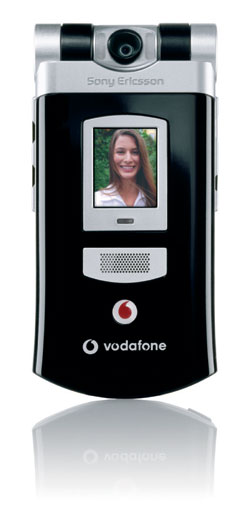
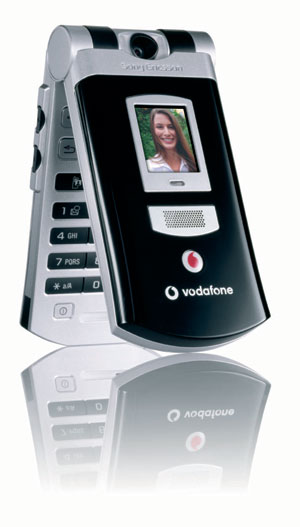
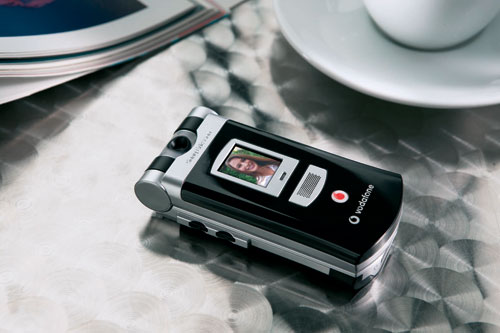
In the beginning of the year Sony Ericsson announced the release of a non-operator version f the V800 called Z800. The difference is in the software than is, naturally, original and not in Vodafone style. Operators' attempts to set the only menu style in all the distributed models lead to the fact a user desire to get rid of this menu. In the majority of cases original menu look better and more comfortable for perception. Other advantages of the mode are not seen at first sight, but come from a long presence of the previous model on the market, that guarantees the absence of rough mistakes in software, some program improvements. An algorithm for processing photos taken by the integrated camera and improved contrast may be referred to the main improvements. We can't say the photos became several times better but slight improvements are observed.

The dimensions remained big (102x49x23.6 mm, 128 grams), having put the device near the P900 you will see it is a bit shorter but thicker. These dimensions are acceptable for the 3G phone today but in the end of the spring and the beginning of the summer they will seem big. The market will be flooded with many 3G devices in small bodies. The tendency will grow by the end of the year; just remember Motorola v1150 (a UMTS variant of V3 RAZR). Comparing the device with Samsung Z110 (closest functional copy) you'll understand the dimensions are typical fort he class. The device is nice to deal with in everyday life; it may be put into the jacket pocket but not into the shirt one. It is a typically men phone not only looking bad in a woman's hand but being quite uncomfortable to hold for them.


In difference to the Z1010 and the majority of modern 3G phones the manufacturers refused an internal camera for video connection but integrated the main one with a rotating mechanism. In this or that way the construction is known by Korean manufacturers and is used by them for several years. The camera may be hidden in a usual condition to prevent from dust and the objective being seen. Light diodes are on both sides of the lens (3 on each side), they serve as a flash. Also the LEDs may be used as lanterns, a separate button responsible for than is on the right side.


The dimensions of the camera module are suitable for integrating a CCD-matrix, but it was refused because of marketing reasons. If you need the maximum photo quality have a look at the S700, the model being considered provides with worthy but middle. Approximately these reasons were brought by the company market specialists.
The external screen is 65K cSTN with the resolution of 101x80 pixels. The screen is practically unreadable in the sun that is typical of such matrixes. No similar problems appear indoors. A photo of a caller is shown at the incoming call, it is possible to make out and also see a number. A service indicator is under the external screen, a loudspeaker hole is also here, it is responsible for reproducing a call melody.



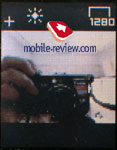
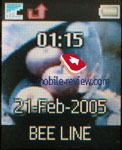
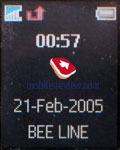
Two separated volume buttons are seen on the left-side surface, an IrDA gap is distinguished with a black plastic in the very end. It is almost placed on the edge of the phone that is sometimes uncomfortable, especially when trying to place another phone having an IrDA gap on the same side nearby. On the other hand that is more comfortable to send data when the receiving phone is in hands.

There is a standard interface connector on the bottom end, the model supports the whole spectrum of the accessories for the phone. A light activating button and a separate camera button are on the right side. The camera works even with the phone closed, no peculiarities.


Opening the device with one hand is possible if having big arms, otherwise it's uncomfortable. Inside you'll see a large 262K TFT screen. The resolution is 176x220 pixels. Principally, the same matrix as in the S700 may be integrated into the phone, and we'll certainly see it in the next devices. An intermediate solution was applied consciously to provide the model with serious differences.

The picture fades in the bright sun but still may be made out. In general the picture quality is rather high, the image looks smooth and bright. Surely the device looses to Samsung and Sharp models. For instance, comparing the same photos on Samsung Z110 and Sony Ericsson Z800 we see the latter loosing. The colours are not as bright, small elements are outlined too sharp making an unpleasant feeling. If not to put the phones near, you won't notice and difference and only direct comparison reveals differences. Despite this fact the screen quality is quite worthy, the device has no many rivals in the parameter for today.


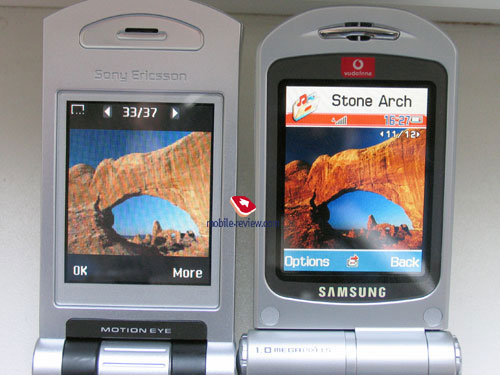
There was plenty of room for a keypad, and thus it allowed not economizing on the size of a button, they are middle and well-distanced. There is a 4D navi button with an OK one inscribed.

A number keypad is deeply sunk into the body having soft and little key motion. These all makes a pleasant feeling when dialing a number, but the keypad fails in comfort when typing a message in.
The manufacturer claims of a Memory Stick Pro DUO support, at the same time we found no expansion clot outside. That is an evident deterioration as compared with previous models - you have to take a cover off and only then replace the card. Hot change works without problems, memory card of any type are supported, that all allows using the devices as an mp3 player.

There is a 900 mAh Li-Pon battery (BST-33). According to the manufacturer, it is capable of working for up to 240 hours in the standby mode and up to 10 hours of talks. In Moscow the device averagely worked for about 4 days in case of one hour of talks and up to an hour of using other functions a day. If working less with the phone, it will work about 5-6 days. Full recharging takes about 2 hours. We should admit the Z800 is a winner in battery life in its class having twice higher characteristics than the rivals do, it is a great advantage of a model.

Menu
Technologically, the device is a complete copy of the last models by the company in ideology; we failed in finding any changes. The integrated memory capacity forms 5MB that is compensated with a 64MB card included into the kit. Working with the memory card differs from using the internal memory in nothing. You may set personal cal signals, choose melodies for calls from there.

The main menu is represented with four rows with three icons in each. You also may use fast navigation with the number series, and then switching to a necessary item will take some seconds.

The input convenience remained on the same level, by pressing the # key you will bring up available language list, and be able to switch between them while text input.
The manufacturer decided to take care of additional horizontal theme bookmarks. This means that now when you are in the call list menu, which is called by pressing the Call button, you will see not only the last dialed numbers but gain the ability to switch between bookmarks with last missed/received calls (horizontal joystick presses). In the phone's menu such navigation is used in all possible places, it strongly simplifies usage of phone; menu's ergonomics in this model is extremely high. I'd like to point out those similar horizontal panels present in the phone book, settings menu and several other menu items as well.
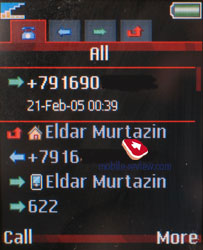
Phone book. As different to the previous models up to 510 names with all the fields filled in are supported. Summing up, we get more than 2000 numbers that are more than enough for the majority of users. And a poll carried out on our site proves the same.
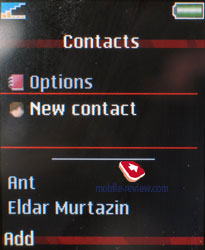
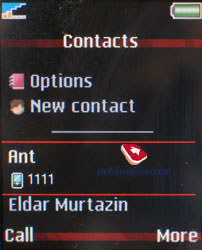
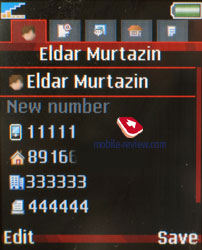
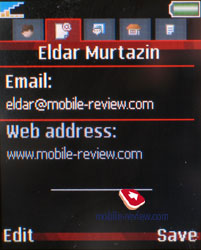
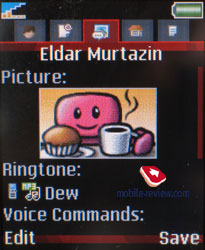
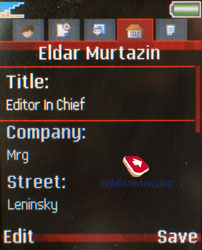


Several phone numbers, e-mail address and other contact information may be kept for a name in the internal memory. In settings you can choose the required fields, as well as sorting by various fields including name, surname, but the input field remains single. Such sorting is important only while transferring data from PC, for phone's entries it's actually useless. For separate names you can setup custom ring tones and own picture, while the incoming call you will hear the custom ring tone, as well as chosen image.
While information input you are free to scroll between bookmarks, on the first one phone number entering and their sorting according to types. Actually this organization reminds Outlook for some reason, it is convenient. Ability to add voice dialing to separate numbers stored under one name was introduced as well, there can be up to 40 of them in total. If you remember, earlier on voice dialing was supported only for names, and you had to make additional voice dialing bookmarks for other phones stored under the same contact.
While viewing the phone book you can scroll the numbers by the horizontal joystick's keypress, as well as watching other information. Of course the default number will be bind by you.
Traditionally the company believes that SIM-card and its memory will be used only in emergency situations, and not for storing information continuously. Viewing the entries on the SIM-card is possible from the separate menu item; they are not displayed in the common entry list.
Messages. All functions are basic for messages; templates and ability to create your own ones are present. For messages storing phone's memory as well as SIM-card's is used. Chat function is supported, on the whole I can say that the features are pretty common for any other phone. Appeared emoticons should be mentioned as well, they are made on a new quality level, and support youth part of the phone.
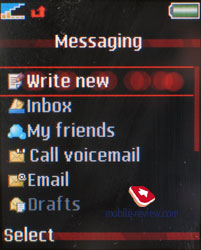
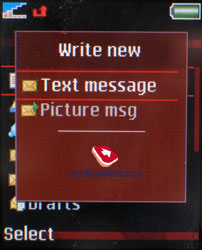
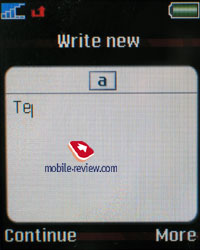
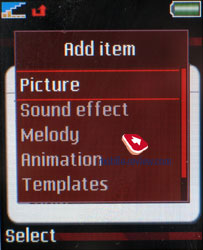
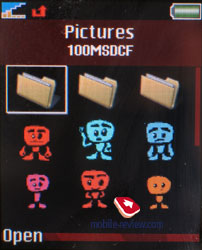
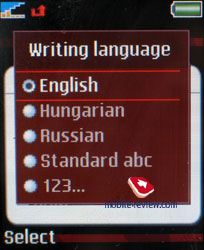
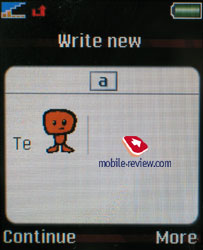
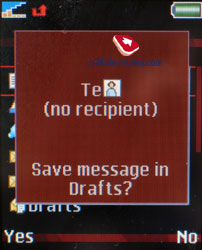

MMS realization deserves to be mentioned as well, you can actually create clips, there are a lot of settings and it is not hard to use them, a truly unique quality that other phones lack.

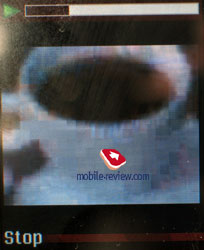

E-Mail client supports sending and receiving messages, all possible encodings are supported.
In this menu Instant Messaging is present as well, sort of ICQ analogue.
Call list. In common list you will see up to 30 entries with date and time assigned to each. Near each of them an icon will explain to what type of call it refers (missed, received, dialed). Besides this in common list additional icons are present, they show if the phone number is present in the phone's memory, or SIM-card's. The list of missed calls can be viewed separately, it can store up to 10 entries. In the same menu item information about cost and length of last, all calls can be viewed. Moving through the separate lists can be made with the help of bookmarks, this actually saves your time greatly.
Entertainment. This menu item contains access to picture album, list of music files. Function MuiscDJ is interesting, although it is rather niche and will not be in demand around most of users. In this editor you can create your own ring tones and edit up to 4 tracks.

A graphical editor for drawing simple pictures is for creative people. Sometimes it helps to while away the time, though mainly the function is unnecessary.
Organizer. In organizer menu a lot of functions are stored at once, first of all - let's review the calendar. There are three types of event view, monthly, weekly and daily. In last case you see the list of all things to do and reminders, in two other modes you will notice the highlighted time with events or the day. Fast transfer to the required year, day and month is present. Everything is pretty simple and traditional, as well as schedule entry. Basically you get the chance to choose one of the 6 icons assigned to the action type, specify the place where it will occur, length and setup reminder (beforehand or in the entered time). I was unable find a way to setup reoccurrence rate; in my samples this feature was not present at all. From the editing menu for separate events you can choose another time and date, and that's it. Reminders work even if the phone is turned off, in case you turn on this function in the settings menu. Pleasant peculiarity of this model is that you can turn on/off automatic switch of profiles after the event had occurred, as well as return to the earlier set profile after the event is over. Basically we get analogue of Time Profile function in Nokia's phones.
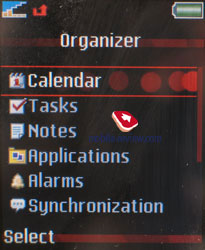
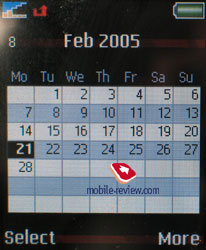

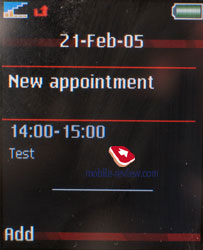
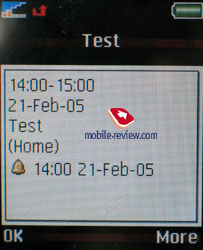
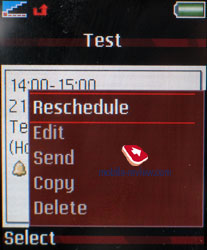
To do list of rather ascetic, only two modes of events, call or reminder. On the other hand this is pretty enough, simplicity has its own advantages as well.
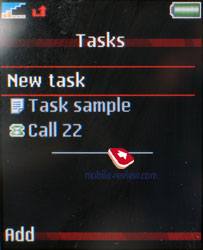
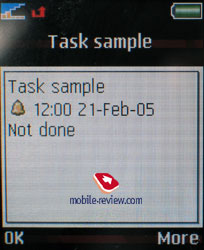
The phone has fully-functional search, which is organized for calendar, you just enter the words (or part of it) and after few seconds see all events which suit for the searched words. Function works very fast even if there are more than 100 entries, fast teleportation to the event is supported as well.
The phone has normal support of sending files to different devices (like always - IrDA, Bluetooth). You just choose the required interval (day, week, or month) and send all entries. I'd like to point out the fact that receiving device must support PIM function in order to receive and display these data files correctly. When we tried to send our own schedule to TV-set it was successful, although it could not be displayed (via IrDA). Same thing can be sent from your office or home PC without any additional software for synchronization.
Notes. The phone supports recording short text notes; in common list first word from each is displayed. This is not always convenient since you have to enter every note with "marker word", in order to remember what it is all about.
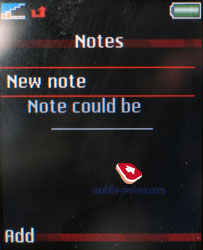
Alarm clocks. The phone has single as well as reoccurring alarm clock, which can be setup by the defined days of week. The alarm clocks will work even if the phone is turned off.
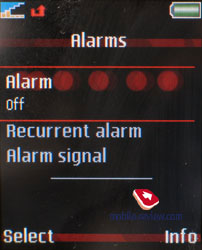
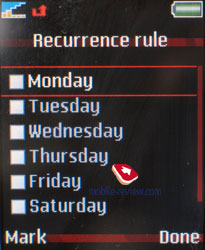
Countdown timer. Everything is pretty simple here, although same thing can be said about the stop-watch, it supports intervals. The phone has code storage, which was loved by many, working with calculator is ordinary.
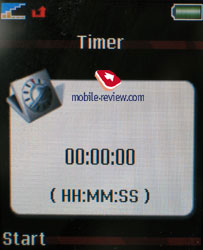
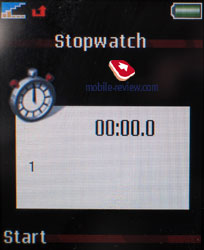
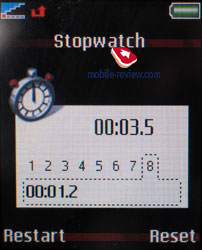

Also a unit converter and a world time function are present.
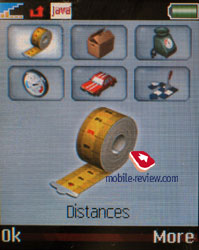
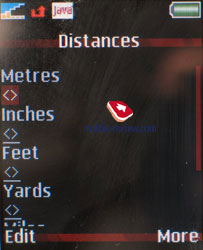
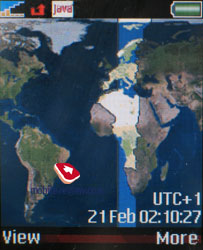
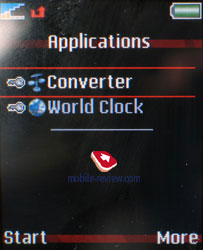
Connectivity. From here you can setup all communication settings of the phone starting with WAP, GPRS and ending with synchronization. The standard usage will not be mentioned, it is pretty obvious, everything works. I'd like to stress that no problems were encountered while synchronizing, synchronization with devices runs smoothly, all profiles are supported.

The same menu provides local and remote localization settings, everything is also standard. The device supports the HID profile that allows using it as a remote controller for a computer or other device.
The following Bluetooth profiles are supported:
- Dial-up networking profile
- Generic Access profile
- Generic Object Exchange Profile
- Object Push Profile
- Serial Port Profile
- Handsfree Profile
- Headset Profile
- Synchronization Profile
- Basic Imaging Profile
- File Transfer Profile
- HID Profile
The model differs from Sony Ericsson K600 in the absence of such profiles as SyncML OBEX binding, JSR-82 Java API. That is another sign the model was manufactured much earlier than the K600.
WAP. The browser was given separate menu item's sport, its version is 2.0 and it supports secured transfers, which is important for electronic transactions. With the help of browser you can download new wallpapers, themes, ring tones, everything is available on the original web-site.

Settings. Basically all settings related to the work with the phone are stored here, partly with the appearance of screens. I will not describe this menu item, since everything is too common. The presence of updated themes should be mentioned though, they actually differ the appearance nicely.

File manager, amount of memory. The user can have about 5 Mb of free space, on which his data, files (pictures, video clips, and applications) can be stored. The manufacturer accounts the user will permanently work with a memory card and thus they try to make it half-stationary preventing from frequent changing.

The phone also gained simple file manager, with its help you can sort files into various folders, create directories in the phone's memory and store files in them. The device may be used for transporting files of any format, everything works without problems. In future you will be able to send files via IrDA and Bluetooth in near future.

Player. The phone has built-in mp3 file player, as well as 3GP. The player is actually a nice tool for listening to mp3 files. Equalizer setup is present among the other settings (Bass, Voice, Tremble etc), as well as the ability of creating your own settings. Depending on these settings the sound will actually change, this is noticeable. The presence of a memory card turns the Z800 into a fully-functional mp3 player with good quality.
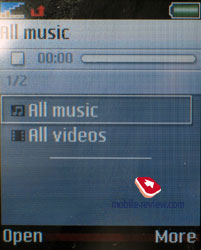
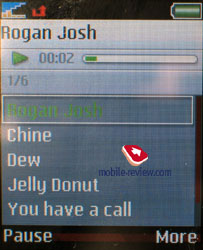
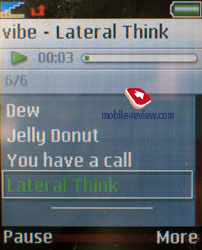
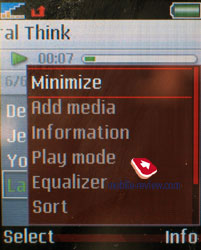
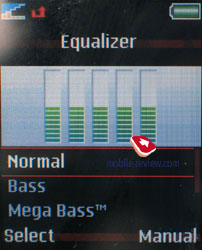

Camera. A 1.3 MP camera is integrated into the phone; in difference to Sony Ericsson S700 the matrix is CMOS that worsens the picture quality even in a sunny day. Noises are clearly seen on indoors photos, especially when lacking lights. The flash is optional (better than in the K600) and making no any influence on the quality of the photos.
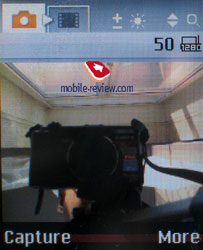
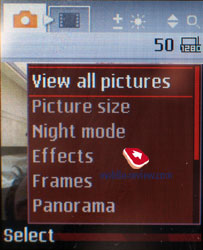


Three possible resolutions are supported - 1280x1024, 640x480, 160x120 pixels. There is no a possibility to choose a compression level, the photos are always of the highest quality.
The camera settings look the following way:
Automatic camera off. When not used the camera turns off automatically in 30 seconds, 1, 2 or 3 minutes.
Shutter sound. You can choose on of the three shutter sounds but not turn the sound off.
White balance. A possibility to choose between an automatic mode or Incandescent, Fluorescent, Daylight, Cloudy.
Light. Backlighting activation, also may be turned on by shifting a left-side cover.
Effects. Several effects may be applied to the photos, they are Negative, Solarize, Sepia, Black & White.
Timer is activated for a certain time period for self shooting.
Night mode is for shooting in the dark. Noises raise on a photo, exposition is increased (you shouldn't move the device in order not to get a blurry photo).
Shooting mode. Normal mode, that is taking usual photos. A multiple mode (Burst 4) allows taking four photos for a series. The last mode is taking photos with frames; there are 14 of them in the phone.
Java. The phone supports Java (MIDP 2.0), as well as 3D-engine, which allows launching truly three-dimensional games (not only Mascot Capsule is supported but JSR-184 also). Some games already known by other models of the company are preinstalled. 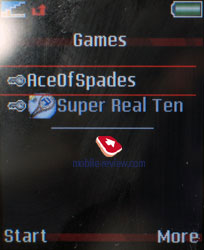 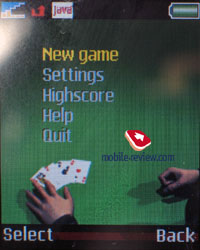 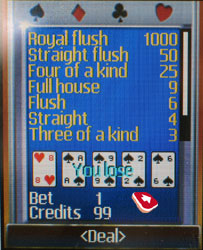 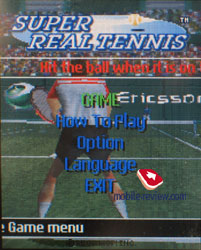 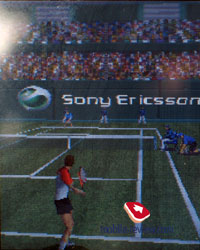  Productivity. We used JBenchmark to measure the device's productivity, and its supporting 3D Java allowed launching a corresponding test. It gave the following results: JBenchmark 3D M3G Version 1.0 Comparing the results with Sony Ericsson K600 we see they are almost the same. That is a typical for today phones productivity level. Only Motorola E1000 is inferior to Sony Ericsson's phones in operating speed. For instance, Siemens 65-series phones have greater performance - about 120 points in average. We do not compare productivity with smartphones, since they will no doubt exceed usual phones. This rather low score is caused by a relatively "row" 3D Java in the model, the company integrated the standard to compete with other manufacturers. The main emphasis of the model is put on Mascot Capsule Engine providing high operating speed and being less resource demanding. Unfortunately, we failed in finding games for 3D Java similar to the preinstalled ones, but subjectively, Mascot Capsule's productivity is much higher. The second version of the test package gave the resulting score of 245. The result is very high and quite comparable with smartphones' operating speed, for instance, the last generation model Nokia 6630 (the bets score was 246). The productivity is also very high and close to the maximum. Indeed, as for the Java virtual machine speed the phone is one of the strongest in its class, even comparable with smartphones. ImpressionsThe device has no problems with the connection quality. The volume of its 72-tones polyphonic call signal is average if having usual midi melodies. It even is lower than in Sony Ericsson K600, K700. Setting midi files seems wrong when supporting mp3 files as a call signal; mp3 compositions are better recognizable and louder. In principle, the volume is a stumbling block of the model, someone will find it low and others will say it's all right. You should better try yourself and form personal opinion. As for me, the main disadvantage of the signal is it has no margin of safety, necessary to set the maximum volume level. A vibrating alert doesn't rectify the situation, since it may be missed if not wearing the phone close to your body, that seems rather unreal considering the dimensions. 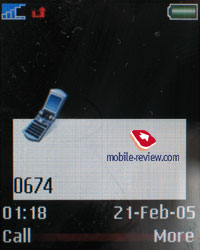 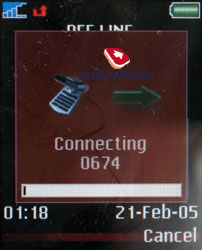 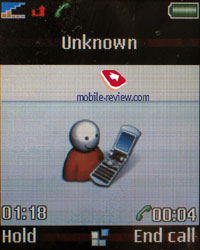  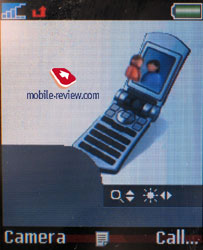 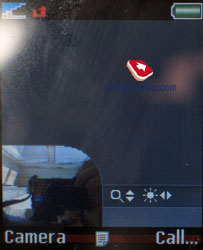 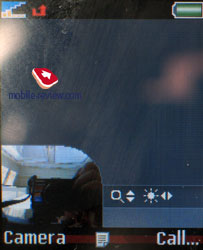  Considering the total phone possibilities, we can claim it is only a reference platform - the model the company perfected its technologies on before integrating into the new ones. Direct USB-connection to a PC, working with a 3D engine, support for many Bluetooth profiles are such technologies. At the launch moment in a Vodafone network the device was very interesting having no direct rivals. Now many of you have already seen a renewed Samsung UMTS-line, the devices are on the same level or even better. The device is primarily interesting for 3G networks; it shouldn't be bought as a usual clamshell, since the price is high and possibilities are good but on a usual level without eminent characteristics. There are models launches offering the same functionality in a smaller body, for instance, the K750i. The phone will appear in the end of April, the beginning of May with the price of 550-600 USD. That will provide stable but not eminent sales. We see no great sense in buying the Z800 in the absence of 3G networks. That is per se a changed S700 with a worse camera, some revisions but no principal changes. The next UMTS-clamshell by the company will appear in September, October 2005, and there is no sense in waiting for it if you need a device now. And thus we get a limited target group of the model. The design and assembling quality are advantages of the phone. | |||
|
| |||
technorati tag as:






3 comments:
Fliptop galore. Yey!
Sexy Celebrity Features
so its not about cgi anymore seems like they included symbian platform here
sexy actor
it's nice to know that they're going to release a non-operator version of V800. .
Post a Comment